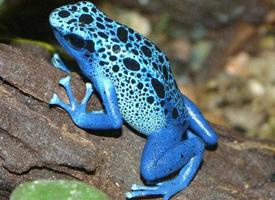
Váhy a míry
| Délka | od 30 do 45 mm |
|---|
Biologická data
| Délka života | od 4 do 12 let |
|---|
Stav ohrožení
| Ohrožen |
Popis zvířete
The Blue Poison Dart Frog, scientifically known as Dendrobates tinctorius "azureus", is a stunningly vibrant amphibian that belongs to the family Dendrobatidae. This species is particularly renowned for its striking blue coloration, which can range from a deep cobalt to a lighter sky blue, interspersed with spots or patterns of black that enhance its allure. Native to the forests of southern Suriname and adjacent regions in Brazil, these frogs have adapted to a life in humid environments, thriving in the understorey layer where moisture is abundant.Adult Blue Poison Dart Frogs are relatively small, typically reaching about 1.5 to 2 inches (4 to 5 cm) in length. Despite their diminutive size, they possess a bold demeanor, often seen actively foraging during the day. They exhibit a remarkable level of parental care, which is not common among amphibians. After the female lays her eggs, the male takes on the responsibility of keeping them moist until they hatch into tadpoles. Upon hatching, one of the parents will transport the tadpoles on their back to a suitable water-filled location, such as a bromeliad axil, where the tadpoles will continue their development into froglets.
The diet of the Blue Poison Dart Frog in the wild primarily consists of ants, termites, and other small insects. These arthropods contribute to the frog's toxic secretions, which are used as a defense mechanism against predators. The toxins deter predation, allowing these conspicuous amphibians to move freely during daylight hours. However, in captivity, where their diet does not include these toxic arthropods, they do not produce the potent toxins found in their wild counterparts.
The vibrant coloration of the Blue Poison Dart Frog is a classic example of aposematism, where bright colors serve as a warning to potential predators about the toxicity of the organism. This evolutionary strategy has enabled them to have fewer natural predators, although they still face threats from larger species and habitat loss.
Conservation efforts are crucial for the survival of the Blue Poison Dart Frog, as their habitats are increasingly threatened by deforestation, pollution, and climate change. Protected areas and captive breeding programs have been established to safeguard their populations, but ongoing efforts are necessary to ensure their continued existence in the wild.
In captivity, these frogs have become popular among amphibian enthusiasts due to their striking appearance and interesting behaviors. They require specific conditions to thrive, including high humidity, appropriate temperatures, and a diet that can be supplemented to ensure their health and well-being.
The Blue Poison Dart Frog is a fascinating creature that captures the attention of scientists, conservationists, and hobbyists alike. Its existence underscores the importance of tropical forest conservation and the intricate balance of ecosystems, where even the smallest creatures play significant roles.
Nové fotografie zvířat
Top 10 zvířat
- Chinese water dragon (Physignathus cocincinus)
- Galápagos tortoise (Geochelone nigra complex)
- Dolphin gull (Leucophaeus scoresbii)
- Japanese macaque (Macaca fuscata)
- Colombian red howler (Alouatta seniculus)
- Sea urchins (Echinoidea)
- Moustached guenon (Cercopithecus cephus)
- Diana monkey (Cercopithecus diana)
- Common reed warbler (Acrocephalus scirpaceus)
- Common house mosquito (Culex pipiens)